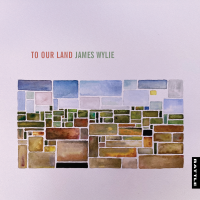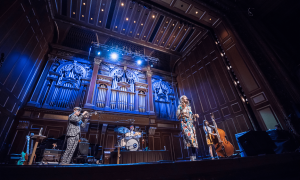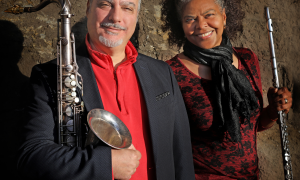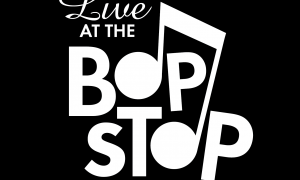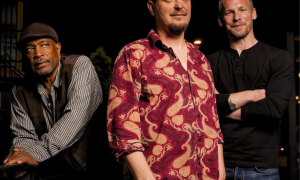Formed in 1960 as a subsidiary of Archie Bleyer's Cadence Records, the Candid label was headed by Nat Hentoff, who was given complete control of who and what he wanted to record. By then, Nat was well established as one of the country's leading jazz writers and civil rights activists. Nat recorded 34 albums, among them important records by a range of jazz artists, including Charles Mingus, Max Roach, Eric Dolphy, Booker Little, Phil Woods, Don Ellis and blues artists Otis Spann, Memphis Slim and Lightnin' Hopkins.
But Nat's efforts were short-lived. Before long, it became clear to Nat that what he loved didn't necessarily translate into dollars or even operating liquidity. In late 1961, Cadence shuttered Candid. The parent company had been first to record the Everly Brothers and Andy Williams before both artists moved on to major recording careers at bigger labels. In 1964, Cadence itself closed down, and Bleyer sold both catalogs to Williams, who owned Barnaby Records.
Nat later viewed his two years at Candid with a heavy heart. In his 1997 memoir, Speaking Freely, Nat wrote with irony, “The fantasy was common to jazz buffs, as we used to be called. [That] someday, somehow, I would have my own record label and record my favorite musicians. The releases would be pure jazz, and therefore would last for generations. Untold numbers of people all around the world would remember my name gratefully.”
While Nat's work as A&R chief was time-consuming and thankless due to low interest and sales, the fruit of his labor is a catalog of music that documents important artists at their peak and most free, artists who now are gone. As Nat discovered, even good taste required marketing dollars and hits. On a personal note, Nat was a leonine mentor who called frequently to chat, praise my JazzWax interviews, pushed me to call his book editor (who, in turn, bought my pitch for Why Jazz Happened) and thunderously encouraged me to keep JazzWax going no matter what. Nat died in 2017.
In 2019, Candid was sold to Glen Barros and Exceleration Music. Barros brought on John Burk, Charles Caldas, Amy Dietz and Dave Hansen as partners, and they are now remastering and reissuing Candid albums. The following five are just out on CD and streaming and will be available as vinyl albums on June 24. The sound is terrific:

Charles Mingus Presents Charles Mingus
Original Faubus Fables was called “original" because the version released a year earlier on Columbia's Mingus Ah Um did not include the vocals by Mingus and Richmond. Suits at Columbia wouldn't allow the taunts chastising Arkansas governor Orval Faubus, who refused to comply with the Supreme Court's ruling vacating the segregation of public schools. In 1960, Columbia Records forbade Candid from entitling the song Fables of Faubus, fearing a backlash in sales of Mingus Ah Um. So Hentoff and Mingus re-titled Mingus's song.
Overall, the album today feels a bit ponderous and long-winded. But in all fairness, at the time of its release, the record was a daring political statement that took on a Southern governor's segregationist stand and boldly defied norms. Go here.

Max Roach—We Insist!: Freedom Now Suite (Dec. 1960) is another timely musical political statement that advocated for racial equality. The album consists of five pieces addressing the Emancipation Proclamation and the African independence movement. Roach and vocalist Abbey Lincoln appear on all five tracks. The rest of the album features different musicians on different songs, including Booker Little (tp), Julian Priester (tb), Walter Benton, Coleman Hawkins (ts), James Schenk (b), Michael Olatunji (congas, vocals) and Raymond Mantilla and Tomas du Vall (perc). Overall, the music was more potent and blunt as a civil rights statement than Mingus's album, but both works were milestones in the movement and nudged folk revivalists to focus on the civil rights struggle rather than on the abstract plight of workers, a 1940s and early '50s folk cause. Go here

Abbey Lincoln—Straight Ahead (February 1961) features Booker Little (tp), Julian Priester (tb), Eric Dolphy (as, bass cl, fl, piccolo), Walter Benton, Coleman Hawkins (ts), Mal Waldron (p), Art Davis (b),
Max Roach (d) and Roger Sanders, Robert Whitley (congas). Four of the seven tracks were co-written by Lincoln. Widely considered to be her most important album, the music overall remains urgent and Lincoln's voice and jazz-folk lyrics are delivered like spirituals. Straight Ahead remains a message album with bite, much in the way Marvin Gaye's What's Going On would make a similar conceptual statement 10 years later. Among the highlights are Lincoln's vocal on Blue Monk, African Lady and Retribution. Go here.

Otis Spann Is the Blues
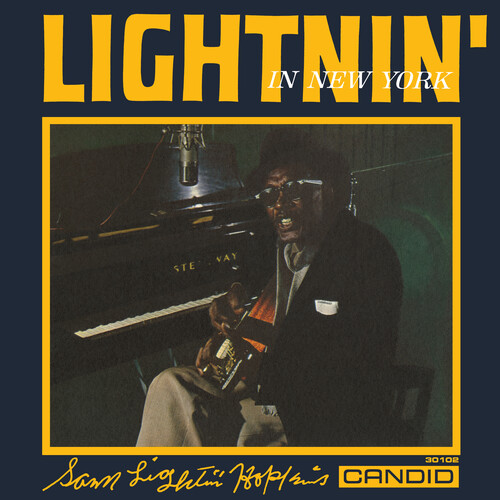
Lightnin' Hopkins—Lightnin' in New York (1961). All eight blues on the album are by Hopikins. The same goes for the singing and guitar playing. The Texas blues artist was discovered playing in Houston in 1946 by Lola Anne Cullum of Aladdin Records, the Los Angeles-based label. She had him travel to L.A., where he recorded for Aladdin with pianist Wilson Smith. They recorded 12 sides. Hopkins returned to Texas in 1947 and recorded for Gold Star in Houston for years. In 1959, blues researcher Robert McCormick presented Hopkins to integrated audiences during the folk revival movement in Houston and California and then at New York's Carnegie Hall in 1960, where he came to the attention of Nat at Candid.
But Nat's efforts were short-lived. Before long, it became clear to Nat that what he loved didn't necessarily translate into dollars or even operating liquidity. In late 1961, Cadence shuttered Candid. The parent company had been first to record the Everly Brothers and Andy Williams before both artists moved on to major recording careers at bigger labels. In 1964, Cadence itself closed down, and Bleyer sold both catalogs to Williams, who owned Barnaby Records.
Nat later viewed his two years at Candid with a heavy heart. In his 1997 memoir, Speaking Freely, Nat wrote with irony, “The fantasy was common to jazz buffs, as we used to be called. [That] someday, somehow, I would have my own record label and record my favorite musicians. The releases would be pure jazz, and therefore would last for generations. Untold numbers of people all around the world would remember my name gratefully.”
While Nat's work as A&R chief was time-consuming and thankless due to low interest and sales, the fruit of his labor is a catalog of music that documents important artists at their peak and most free, artists who now are gone. As Nat discovered, even good taste required marketing dollars and hits. On a personal note, Nat was a leonine mentor who called frequently to chat, praise my JazzWax interviews, pushed me to call his book editor (who, in turn, bought my pitch for Why Jazz Happened) and thunderously encouraged me to keep JazzWax going no matter what. Nat died in 2017.
In 2019, Candid was sold to Glen Barros and Exceleration Music. Barros brought on John Burk, Charles Caldas, Amy Dietz and Dave Hansen as partners, and they are now remastering and reissuing Candid albums. The following five are just out on CD and streaming and will be available as vinyl albums on June 24. The sound is terrific:
Charles Mingus Presents Charles Mingus
Original Faubus Fables was called “original" because the version released a year earlier on Columbia's Mingus Ah Um did not include the vocals by Mingus and Richmond. Suits at Columbia wouldn't allow the taunts chastising Arkansas governor Orval Faubus, who refused to comply with the Supreme Court's ruling vacating the segregation of public schools. In 1960, Columbia Records forbade Candid from entitling the song Fables of Faubus, fearing a backlash in sales of Mingus Ah Um. So Hentoff and Mingus re-titled Mingus's song.
Overall, the album today feels a bit ponderous and long-winded. But in all fairness, at the time of its release, the record was a daring political statement that took on a Southern governor's segregationist stand and boldly defied norms. Go here.
Max Roach—We Insist!: Freedom Now Suite (Dec. 1960) is another timely musical political statement that advocated for racial equality. The album consists of five pieces addressing the Emancipation Proclamation and the African independence movement. Roach and vocalist Abbey Lincoln appear on all five tracks. The rest of the album features different musicians on different songs, including Booker Little (tp), Julian Priester (tb), Walter Benton, Coleman Hawkins (ts), James Schenk (b), Michael Olatunji (congas, vocals) and Raymond Mantilla and Tomas du Vall (perc). Overall, the music was more potent and blunt as a civil rights statement than Mingus's album, but both works were milestones in the movement and nudged folk revivalists to focus on the civil rights struggle rather than on the abstract plight of workers, a 1940s and early '50s folk cause. Go here
Abbey Lincoln—Straight Ahead (February 1961) features Booker Little (tp), Julian Priester (tb), Eric Dolphy (as, bass cl, fl, piccolo), Walter Benton, Coleman Hawkins (ts), Mal Waldron (p), Art Davis (b),
Max Roach (d) and Roger Sanders, Robert Whitley (congas). Four of the seven tracks were co-written by Lincoln. Widely considered to be her most important album, the music overall remains urgent and Lincoln's voice and jazz-folk lyrics are delivered like spirituals. Straight Ahead remains a message album with bite, much in the way Marvin Gaye's What's Going On would make a similar conceptual statement 10 years later. Among the highlights are Lincoln's vocal on Blue Monk, African Lady and Retribution. Go here.
Otis Spann Is the Blues

Lightnin' Hopkins—Lightnin' in New York (1961). All eight blues on the album are by Hopikins. The same goes for the singing and guitar playing. The Texas blues artist was discovered playing in Houston in 1946 by Lola Anne Cullum of Aladdin Records, the Los Angeles-based label. She had him travel to L.A., where he recorded for Aladdin with pianist Wilson Smith. They recorded 12 sides. Hopkins returned to Texas in 1947 and recorded for Gold Star in Houston for years. In 1959, blues researcher Robert McCormick presented Hopkins to integrated audiences during the folk revival movement in Houston and California and then at New York's Carnegie Hall in 1960, where he came to the attention of Nat at Candid.
This story appears courtesy of JazzWax by Marc Myers.
Copyright © 2026. All rights reserved.






